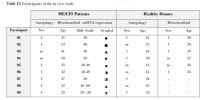Using the Thermal Power of Light to Affect Myalgic Encephalomyelitis/Chronic Fatigue Syndrome (ME/CFS)
Hochecker, Barbara
Abstract
Myalgic encephalomyelitis/chronic fatigue syndrome (ME/CFS) is a complex and poorly understood multisystem disease with an unclear cause and pathophysiology. Diagnosis remains difficult due to the absence of specific biomarkers, so the condition must be identified based solely on clinical symptoms, which vary greatly between individuals in both type and severity. Alongside the primary symptom of debilitating fatigue, patients commonly experience cognitive impairments such as memory and concentration problems, muscle and joint pain, non-restorative sleep, dizziness, and a phenomenon known as post-exertional malaise (PEM), where even minor physical or mental exertion leads to a significant worsening of symptoms. These symptoms often result in severe disability, with some patients confined to bed and unable to participate in normal daily life.
For decades, ME/CFS has been largely neglected by the medical and scientific communities, leading to a lack of knowledge and the absence of causal treatments. Current therapeutic approaches focus only on symptom management, typically involving medications or behavioral therapies designed to help patients adapt to their limitations and possibly regain some level of activity.
This thesis explores the potential of hyperthermia—an artificially induced elevation of body temperature—as a novel treatment option for ME/CFS. Hyperthermia has long been used in cancer therapy and has also demonstrated positive effects in treating severe depression and arterial hypertension, although the underlying cellular and molecular mechanisms remain poorly understood.
The study is divided into three parts. The first part compares key cellular processes—autophagy and mitochondrial function—in peripheral blood mononuclear cells (PBMCs) from healthy individuals and ME/CFS patients. The results show elevated autophagy and increased mitochondrial activity in ME/CFS patients compared to healthy controls. The second part consists of an ex vivo hyperthermia experiment in which PBMCs and fibroblasts from both healthy donors and ME/CFS patients were exposed to one hour of heat at 39°C. This treatment increased autophagy and slightly reduced mitochondrial function. Additionally, gene expression related to these processes was analyzed.
The third part is an in vivo study in which nine ME/CFS patients underwent a one-hour whole-body hyperthermia session using water-filtered infrared-A radiation, raising their core body temperature to 39°C. Unlike the ex vivo results, the in vivo treatment reduced the previously elevated autophagy levels in ME/CFS patients back to normal and enhanced mitochondrial function. Since the in vivo results more accurately reflect the effects on the whole organism, they are considered more relevant for evaluating the therapeutic potential of hyperthermia.
The observed differences between ex vivo and in vivo responses provide a foundation for developing a new hypothesis regarding the pathophysiology of ME/CFS, which is discussed in the thesis. Overall, the results suggest that hyperthermia may be a promising treatment strategy for ME/CFS, capable of normalizing dysregulated cellular processes and improving energy metabolism.
Web | PDF | Konstanz, Univ., Doctoral dissertation | Open Access
Hochecker, Barbara
Abstract
Myalgic encephalomyelitis/chronic fatigue syndrome (ME/CFS) is a complex and poorly understood multisystem disease with an unclear cause and pathophysiology. Diagnosis remains difficult due to the absence of specific biomarkers, so the condition must be identified based solely on clinical symptoms, which vary greatly between individuals in both type and severity. Alongside the primary symptom of debilitating fatigue, patients commonly experience cognitive impairments such as memory and concentration problems, muscle and joint pain, non-restorative sleep, dizziness, and a phenomenon known as post-exertional malaise (PEM), where even minor physical or mental exertion leads to a significant worsening of symptoms. These symptoms often result in severe disability, with some patients confined to bed and unable to participate in normal daily life.
For decades, ME/CFS has been largely neglected by the medical and scientific communities, leading to a lack of knowledge and the absence of causal treatments. Current therapeutic approaches focus only on symptom management, typically involving medications or behavioral therapies designed to help patients adapt to their limitations and possibly regain some level of activity.
This thesis explores the potential of hyperthermia—an artificially induced elevation of body temperature—as a novel treatment option for ME/CFS. Hyperthermia has long been used in cancer therapy and has also demonstrated positive effects in treating severe depression and arterial hypertension, although the underlying cellular and molecular mechanisms remain poorly understood.
The study is divided into three parts. The first part compares key cellular processes—autophagy and mitochondrial function—in peripheral blood mononuclear cells (PBMCs) from healthy individuals and ME/CFS patients. The results show elevated autophagy and increased mitochondrial activity in ME/CFS patients compared to healthy controls. The second part consists of an ex vivo hyperthermia experiment in which PBMCs and fibroblasts from both healthy donors and ME/CFS patients were exposed to one hour of heat at 39°C. This treatment increased autophagy and slightly reduced mitochondrial function. Additionally, gene expression related to these processes was analyzed.
The third part is an in vivo study in which nine ME/CFS patients underwent a one-hour whole-body hyperthermia session using water-filtered infrared-A radiation, raising their core body temperature to 39°C. Unlike the ex vivo results, the in vivo treatment reduced the previously elevated autophagy levels in ME/CFS patients back to normal and enhanced mitochondrial function. Since the in vivo results more accurately reflect the effects on the whole organism, they are considered more relevant for evaluating the therapeutic potential of hyperthermia.
The observed differences between ex vivo and in vivo responses provide a foundation for developing a new hypothesis regarding the pathophysiology of ME/CFS, which is discussed in the thesis. Overall, the results suggest that hyperthermia may be a promising treatment strategy for ME/CFS, capable of normalizing dysregulated cellular processes and improving energy metabolism.
Web | PDF | Konstanz, Univ., Doctoral dissertation | Open Access

